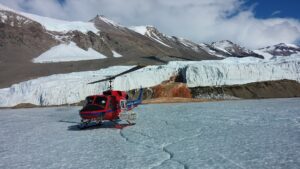The record heat experienced across the globe this summer has taken a major toll on Norway’s ice-covered islands.
NASA satellite imaging revealed record-breaking ice melt in Svalbard, Norway’s arctic archipelago. Between June 1 and July 31, the total ice melt in Svalbard this year was 1.5 times larger than the last record in 2018.
Simply put, 40 gigatons (44 billion U.S. tons, 40 billion tonnes) of meltwater have poured into the Atlantic Ocean from Norway over the last 60 days.
Xavier Fettweis, a climatologist at the University of Liège, told NASA that Svalbard’s snowpack retained about 34 percent of the summer meltwater between 1981–2010. Yet the “firn,” as the layer is called, only retained 8 percent of this summer’s meltwater, Fettweis said.
“The melt anomaly is 3.5 times larger than the 1981–2010 average, and 5 times the interannual variability,” Fettweis said. “Only a changing climate can explain this.”
The area also experienced early snowmelt this year. That primed ice surfaces for melting, Ted Scambos of the University of Colorado at Boulder told Axios.
Temperatures in Svalbard have stayed about 2 to 3°C above average since May — an unusually long time, Scambos said.
“May took away much of the fresh snow, exposing the glacier ice and older snow to warm air and sunlight earlier in the season than usual,” Scambos said.
The image below renders the effect clearly. Light blue areas indicate where snow and firn have melted away, exposing bare ice. Clearly marked melt ponds indicate the softest spots on the surface.

The primary ice melt locations in Svalbard. Photo: NASA
Warming ice, warming mountains
It’s increasingly clear to both climate scientists and climbers that changes like those in Svalbard represent a new normal.
“Svalbard is now losing more ice than it is gaining, and it is clear that this trend will continue in the future,” Fettweis said.
Svalbard has become one of the fastest-warming places in the Northern Hemisphere, according to NASA. It’s a “canary in the coal mine” for climate change, much like the high-altitude mountains that have become more dangerous for climbers in recent years.
Climbers in the Himalaya noted similar changes in the Karakoram. For Adriana Brownlee’s ascent of Dhaulagiri last year, getting to the summit was the easy part. But a melting mountain made the descent hellish, she said.
“The mountain was a melting pot, a vertical river pretty much,” Brownlee posted on social media.






